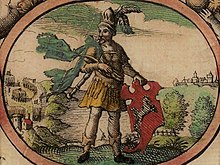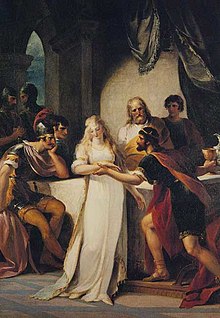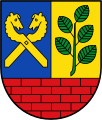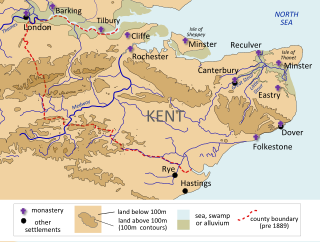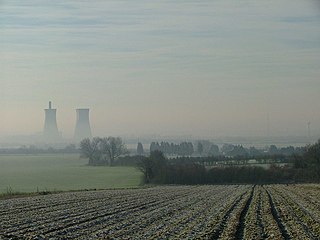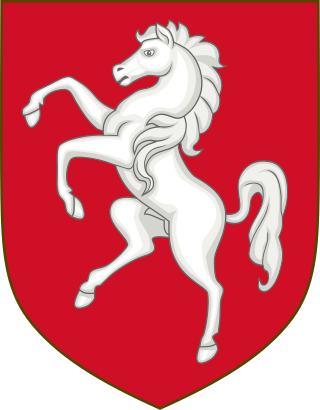Book 6
Geoffrey records that three brigantines or long galleys arrived in Kent, full of armed men and commanded by two brothers, Hengist and Horsa. Vortigern was then staying at Dorobernia (Canterbury), and ordered that the "tall strangers" be received peacefully and brought to him. When Vortigern saw the company, he immediately observed that the brothers "excelled all the rest both in nobility and in gracefulness of person". He asked what country they had come from and why they had come to his kingdom. Hengist ("whose years and wisdom entitled him to precedence") replied that they had left their homeland of Saxony to offer their services to Vortigern or some other prince, as part of a Saxon custom in which, when the country became overpopulated, able young men were chosen by lot to seek their fortunes in other lands. Hengist and Horsa were made generals over the exiles, as befitted their noble birth. [19]
Vortigern was aggrieved when he learned that the strangers were pagans, but nonetheless rejoiced at their arrival, since he was surrounded by enemies. He asked Hengist and Horsa if they would help him in his wars, offering them land and "other possessions". They accepted the offer, settled on an agreement, and stayed with Vortigern at his court. Soon after, the Picts came from Alba with an immense army and attacked the northern parts of Vortigern's kingdom. In the ensuing battle "there was little occasion for the Britons to exert themselves, for the Saxons fought so bravely, that the enemy, formerly victorious, were speedily put to flight". [20]
In gratitude Vortigern increased the rewards he had promised to the brothers. Hengist was given "large possessions of lands in Lindsey for the subsistence of himself and his fellow-soldiers". A "man of experience and subtlety", Hengist told Vortigern that his enemies assailed him from every quarter, and that his subjects wished to depose him and make Aurelius Ambrosius king. He asked the king to allow him to send word to Saxony for more soldiers. Vortigern agreed, adding that Hengist could invite over whom he pleased and that "you shall have no refusal from me in whatever you shall desire". [21]
Hengist bowed low in thanks, and made a further request, that he be made a consul or prince, as befitted his birth. Vortigern responded that it was not in his power to do this, reasoning that Hengist was a foreign pagan and would not be accepted by the British lords. Hengist asked instead for leave to build a fortress on a piece of land small enough that it could be encircled by a leather thong. Vortigern granted this and ordered Hengist to invite more Saxons. [21]
After executing Vortigern's orders, Hengist took a bull's hide and made it into a single thong, which he used to encircle a carefully chosen rocky place (perhaps at Caistor in Lindsey). [22] Here he built the castle of Kaercorrei, or in Saxon Thancastre: "thong castle." [23]
The messengers returned from Germany with eighteen ships full of the best soldiers they could get, as well as Hengist's beautiful daughter Rowena. Hengist invited Vortigern to see his new castle and the newly arrived soldiers. A banquet took place in Thancastre, at which Vortigern drunkenly asked Hengist to let him marry Rowena. Horsa and the men all agreed that Hengist should allow the marriage, on the condition that Vortigern give him Kent. [24]
Vortigern and Rowena were immediately married and Hengist received Kent. The king, though delighted with his new wife, incurred the hatred of his nobles and of his three sons. [25]
As his new father-in-law, Hengist made further demands of Vortigern:
- As I am your father, I claim the right of being your counsellor: do not therefore slight my advice, since it is to my countrymen you must owe the conquest of all your enemies. Let us invite over my son Octa, and his brother Ebissa, who are brave soldiers, and give them the countries that are in the northern parts of Britain, by the wall, between Deira and Alba. For they will hinder the inroads of the barbarians, and so you shall enjoy peace on the other side of the Humber. [26]
Vortigern agreed. Upon receiving the invitation, Octa, Ebissa, and another lord, Cherdich, immediately left for Britain with three hundred ships. Vortigern received them kindly, and gave them ample gifts. With their assistance, Vortigern defeated his enemies in every engagement. All the while Hengist continued inviting over yet more ships, adding to his numbers daily. Witnessing this, the Britons tried to get Vortigern to banish the Saxons, but on account of his wife he would not. Consequently, his subjects turned against him and took his son Vortimer for their king. The Saxons and the Britons, led by Vortimer, met in four battles. In the second, Horsa and Vortimer's brother, Catigern, slew one another. By the fourth battle, the Saxons had fled to Thanet, where Vortimer besieged them. When the Saxons could no longer bear the British onslaughts, they sent out Vortigern to ask his son to allow them safe passage back to Germany. While discussions were taking place, the Saxons boarded their ships and left, leaving their wives and children behind. [27]
Rowena poisoned the victorious Vortimer, and Vortigern returned to the throne. [28] At his wife's request he invited Hengist back to Britain, but instructed him to bring only a small retinue. Hengist, knowing Vortimer to be dead, instead raised an army of 300,000 men. When Vortigern received word of the imminent arrival of the vast Saxon fleet, he resolved to fight them. Rowena alerted her father of this, who, after considering various strategies, resolved to make a show of peace and sent ambassadors to Vortigern. [29]
The ambassadors informed Vortigern that Hengist had only brought so many men because he did not know of Vortimer's death and feared further attacks from him. Now that there was no threat, Vortigern could choose from among the men the ones he wished to return to Germany. Vortigern was greatly pleased by these tidings, and arranged to meet Hengist on the first of May at the monastery of Ambrius. [30]
Before the meeting, Hengist ordered his soldiers to carry long daggers beneath their clothing. At the signal Nemet oure Saxas (get your knives), the Saxons fell upon the unsuspecting Britons and massacred them, while Hengist held Vortigern by his cloak. 460 British barons and consuls were killed, as well as some Saxons whom the Britons beat to death with clubs and stones. Vortigern was held captive and threatened with death until he resigned control of Britain's chief cities to Hengist. Once free, he fled to Cambria. [31]
Book 8
In Cambria, Merlin prophesied to Vortigern that the brothers Aurelius Ambrosius and Uther Pendragon (who had fled to Armorica as children after Vortigern killed their brother Constans and their father, King Constantine) would return to have their revenge and defeat the Saxons. They arrived the next day, and, after rallying the dispersed Britons, Aurelius was proclaimed king. Aurelius marched into Cambria and burned Vortigern alive in his tower, before setting his sights upon the Saxons. [32]
Hengist was struck by terror at the news of Vortigern's death and fled with his army beyond the Humber. He took courage at the approach of Aurelius and selected the bravest among his men to defend him. Hengist told these chosen men not to be afraid of Aurelius, for he had brought less than 10,000 Armorican Britons (the native Britons were hardly worth taking into account), while there were 200,000 Saxons. Hengist and his men advanced towards Aurelius in a field called Maisbeli (probably Ballifield, near Sheffield), [33] intending to take the Britons by surprise, but Aurelius anticipated them. [32]
As they marched to meet the Saxons, Eldol, Duke of Gloucester, told Aurelius that he greatly wished to meet Hengist in combat, noting that "one of the two of us should die before we parted". He explained that he had been at the Treachery of the Long Knives, but had escaped when God threw him a stake to defend himself with, making him the only Briton present to survive. Meanwhile, Hengist was placing his troops into formation, giving directions, and walking through the lines of troops, "the more to spirit them up". [34]
With the armies in formation, battle began between the Britons and Saxons, both sides suffering "no small loss of blood". Eldol focused on attempting to find Hengist, but had no opportunity to fight him. "By the especial favour of God" the Britons took the upper hand, and the Saxons withdrew and made for Kaerconan (Conisbrough). Aurelius pursued them, killing or enslaving any Saxon he met on the way. Realizing Kaerconan would not hold against Aurelius, Hengist stopped outside the town and ordered his men to make a stand, "for he knew that his whole security now lay in his sword". [35]
Aurelius reached Hengist, and a "most furious" fight ensued, with the Saxons maintaining their ground despite heavy losses. They came close to winning before a detachment of horses from the Armorican Britons arrived. When Gorlois, Duke of Cornwall, arrived, Eldol knew the day was won and grabbed Hengist's helmet, dragging him into the British ranks. The Saxons fled. Hengist's son Octa retreated to York and his kinsman Eosa to Alclud (Dumbarton). [36]
Three days after the battle, Aurelius called together a council of principal officers to decide what to do with Hengist. Eldol's brother Eldad, Bishop of Gloucester, said:
- Though all should be unanimous for setting him at liberty, yet would I cut him to pieces. The prophet Samuel is my warrant, who, when he had Agag, king of Amalek, in his power, hewed him in pieces, saying, As thy sword hath made women childless, so shall thy mother be childless among women. Do therefore the same to Hengist, who is a second Agag. [37]
Consequently, Eldol drew Hengist out of the city and cut off his head. Aurelius, "who showed moderation in all his conduct", arranged for him to be buried and for a mound to be raised over his corpse, according to the custom of pagans. [37] Octa and Eosa surrendered to Aurelius, who granted them the country bordering Scotland and made a firm covenant with them. [38]

